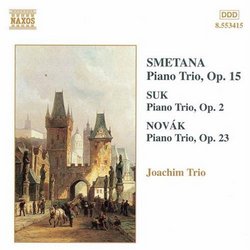| All Artists: Bedrich Smetana, Josef [Composer] Suk, Vitezslav Novak, Joachim Trio Title: Piano Trios Members Wishing: 0 Total Copies: 0 Label: Naxos Original Release Date: 1/1/1998 Re-Release Date: 8/25/1998 Genre: Classical Styles: Chamber Music, Symphonies Number of Discs: 1 SwapaCD Credits: 1 UPC: 730099441520 |
Search - Bedrich Smetana, Josef [Composer] Suk, Vitezslav Novak :: Piano Trios
 | Bedrich Smetana, Josef [Composer] Suk, Vitezslav Novak Piano Trios Genre: Classical
|
Larger Image |
CD Details |
CD ReviewsIntense Smetana, Individualistic Novak 09/09/2003 (5 out of 5 stars) "If you admire Smetana?s other well-known chamber work, the String Quartet No. 1 ?From My Life,? I think you?ll be impressed with Smetana?s G-minor Trio. This came early in his career (1855), and like the Quartet it is inspired by life events?in the case of the Trio, the death of Smetana?s first child. Unlike the Quartet, however, if the Trio has a specific program it?s pretty much hidden beneath a general air of tragic intensity and, in the last movement, a hounded quality in the principal theme that suggests the composer?s ultimate inconsolability. While the piece has a slightly rambling, start-and-stop quality in spots, this is because it seems to follow Liszt?s principal of thematic metamorphosis, the central scherzo-cum-slow-interlude repeating motifs of the first movement?s principal theme, while the driven finale is often interrupted by a tender, elegiac melody spun off the principal theme. By the time this elegy returns, speeded up, vying with the principal melody for dominance of the end of the movement, it is clear that the composer?s hard-won peace is a troubled one. After the tragic drama of Smetana?s trio, Suk?s brief trio, written when the composer was fifteen though revised two years later, is lightweight in both content and emotion. It?s certainly pretty enough, and the finale has a youthful bounce that?s attractive, but the cloying slow movement might induce aural hyperglycemia!Better companion pieces are the Novak Elegy and Trio, especial the Trio, with its fantasia-like structure in which a tragic andante alternates with a allegro burlesco whose burlesque elements are pretty subdued though it has some of the same fragmented quality of Smetana?s intriguing scherzo movement. Kindred minds at work, obviously. The final appearance of the allegro is feverish, impassioned, before the quietly tragic close with pizzicato strings intoning the three-note motif of the allegro. This is a highly individual, very effective recasting of the traditional piano trio.The English Joachim Trio give passionate, committed performances of all four works, doing so without sacrificing beauty of sound. And they make some very beautiful sounds, well captured by the Naxos engineers in a church acoustic that lends a certain lushness to the proceedings, never clouding the music." Is this a regular ensemble? M. Shiell | Australia | 08/30/2009 (3 out of 5 stars) "I bought this CD as I live in an isolated area of NSW, Australia and have to prepare the Smetana Trio for a recital in November on a very limited rehearsal schedule. I had hoped to broadcast it in my Sunday afternoon classical music programme on local radio however, I have chosen not to for two reasons. First, the string playing, ensemble and sound mix was utterly riveting - well done - but the piano sounded like it was made of tin and recorded in a bathroom. Such a shame! Second, the string-piano ensemble is not ideal and sometimes seems diametrically opposed. I became quite annoyed with it in the end. Some of the tempi I don't quite agree with, but obviously, that's a personal matter. I will probably buy another CD in the hope of discovering an ensemble and interpretation that I agree with more."
|

 Track Listings (8) - Disc #1
Track Listings (8) - Disc #1